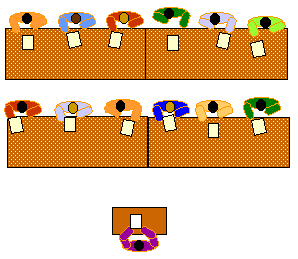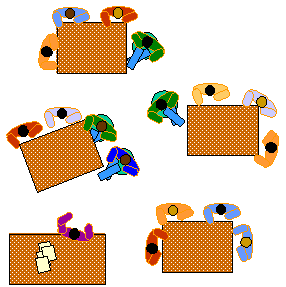The physical surroundings of a class can encourage or inhibit the kind of interaction, and hence learning, which you want. Making distinct efforts to arrange the furniture of a classroom to promote a particular kind of interaction also sends strong messages to participants who are used to conventional layouts that this class is something different. It may be a hassle (particularly when there are instructions to "leave the room as you found it") but it is worth it.
The ability to "make eye-contact" (look someone in the eye, however fleetingly) is—at least in Western culture—the key to establishing communication in a group, and it is particularly important for the teacher.

The traditional classroom layout, in rows, allows the teacher to make eye-contact with all the students (although it is important to keep looking around to move beyond a narrow arc of vision, if you want everyone to feel included). It facilitates traditional teacher-student delivery and questioning, or "teacher-centred" teaching.
The students can also readily see a screen or board at the front.
But in order to talk to each other, they need to turn in their seats or address the back of a fellow-student's neck.
 For whole-group discussion, the U-shape layout is more effective. The students can make eye-contact with each other (although they still have to twist to talk to a person along the same side of the table). However, apart from those along the back, they also have to turn to see whatever the teacher is presenting.
For whole-group discussion, the U-shape layout is more effective. The students can make eye-contact with each other (although they still have to twist to talk to a person along the same side of the table). However, apart from those along the back, they also have to turn to see whatever the teacher is presenting.

If the group is too large to get around a U-shaped layout or a board-room table, the "fishbowl", with concentric circles of students, maximises the possibilities of discussion. Clearly this works better without tables, and it is useful to make efforts to ensure that over several sessions, everyone has their turn in the "inner circle".
For sessions involving small group working, it is useful to arrange tables at which four or five students can sit, to promote the easy formation of the small groups from the start of the session. It encourages talk within the small groups, and exchanges with the teacher, but communication between the groups can be awkward, and people still end up talking to others' backs. It does avoid the disruption caused by people moving about half-way through (although that is sometimes a useful "punctuation mark" in the session).

The moral of the story is, as ever, that there is no single solution: it all depends on what it is you want to do.
However, do be aware of the needs of students with, for example, sensory impairments. The extent to which you privilege their needs over the general social process of the class, or go for a utilitarian solution, is as ever a matter of fine judgement.
This is an archived copy of Atherton J S (2013) Learning and Teaching [On-line: UK] Original material by James Atherton: last up-dated overall 10 February 2013

This work is licensed under a Creative Commons Attribution-Noncommercial-No Derivative Works 3.0 Unported License.
"This site is independent and self-funded, although the contribution of the Higher Education Academy to its development via the award of a National Teaching Fellowship, in 2004 has been greatly appreciated."

